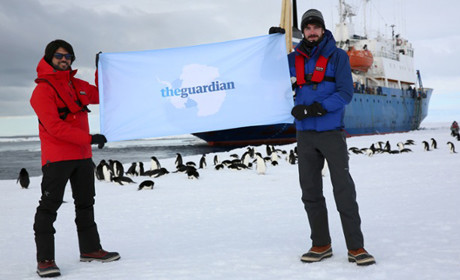
Temperatures of minus 10 degrees, batteries failing due to the cold and interrupted satellite links – these are just some of the challenges faced by two Guardian journalists who spent the last few weeks reporting from the Antarctic.
Covering the Australasian Antarctic Expedition, science correspondent Alok Jha and video/stills journalist Laurence Topham were part of a 50-strong crew of other journalists, scientists and academics attempting to retrace the steps of British-Australian explorer Sir Douglas Mawson, 100 years on.
Despite the technical challenges, the duo posted "among the most southern [tweets] ever sent" as they battled temperatures of minus 10 degrees, resorting to wrapping their laptops in coats to protect the batteries from the cold.
But these problems were far from the biggest challenge for Jha and Topham, after the ship they were on, MV Akademik Shokalskiy, became stranded in thick pack ice on Christmas Day. Plans to evacuate them by helicopter on Wednesday (1 January) were aborted due to hazardous weather conditions, but the Guardian today reported via an ongoing liveblog that the Australian Maritime Safety Authority has been told that everyone has now been rescued by helicopter.
We've made it to the Aurora Australis. Via a v big helicopter from Xue Long. Thank you to everyone who has helped w this amazing operation
— Alok Jha (@alokjha) January 2, 2014
Journalism.co.uk spoke to Jha on Wednesday 18 December while they were in Commonwealth Bay – the windiest place on Earth, where temperatures can drop to minus 20 degrees or lower.
"The aim is to send back something every day," explained Jha. "We're doing articles, pictures and also short videos – a few seconds or a minute – a few times per week and longer ones – three or four minutes – once per week.Our tweets and Vines have been among the most southern ones ever sent – partly we did it just to see how far we can make it workAlok Jha, the Guardian
"In between that, I'm trying to tweet and send Vines as often as possible. Our tweets and Vines have been among the most southern ones ever sent – partly we did it just to see how far we can make it work.
"These have been endlessly shared and retweeted. The images and videos from the trip have been a real triumph in terms in engagement."
Among some of the challenges Jha and Topham face are temperatures of minus 10 degrees. The climate has also caused issues with batteries, which swiftly deplete when the temperature drops.
"A full laptop charge can disappear in an hour or less," Jha explained. "On the ship, it's warm and we can work normally. But once we take the cameras outside it becomes a slight problem."
However, the biggest issue, Jha said, is the amount of time large files such as video, audio and pictures take to upload, given the slow internet connection.
To upload content, Jha and Topham need to go to the top of the ship, in line of sight with a satellite, to get a connection – and there are no plug sockets up there.
"The laptop has run out of juice halfway through an upload more than once," Jha said. "We've resorted to wrapping the laptops in our insulated overcoats while they upload, that seems to keep them going longer."
Jha and Topham are using a BGAN [satellite] system to send copy and images back to the Guardian newsdesk. The rest of the kit is the same as they would use for regular work but, as Jha points out, in such extreme conditions "it just needs a bit of thought before using it".
"Laurence has a waterproof and insulated jacket for his main Sony video camera," he explained. "And we have a Canon 5D that is weather sealed but we just make sure to warm it up slowly when coming in from the cold, to avoid condensation inside the unit."
Jha said his worst moment in Antarctica was staying up until 3am one night, outside on the cold and windy deck, trying to send a video of the ship's progress through the sea ice.
"It took three attempts. Each time we failed because of some combination of the ship moving a degree to the left or right and we lost our [satellite] connection; the laptop battery got cold and died; the sat phone battery got cold and died; the computer would lose our upload page on the transfer website," said Jha.We've resorted to wrapping the laptops in our insulated overcoats while they upload, that seems to keep them going longerAlok Jha, the Guardian
"We sent the video in the end but it was not a fun night. The video was really fantastic, though, and I think it got a great response online."
However, the best moments Jha said, keep getting beaten every day. His best day yet, he told us, was cruising between the ice floes in the Southern Ocean. "It was the first time we'd been off the boat in a week and the weather was gorgeous - cold but bright. We saw penguins, seals, a whale… and there were icebergs in the distance".
And the thing he's most looking forward to doing when he gets back to the UK?
"Seeing the family and friends," Jha said. "It's been very hard to stay in touch. We just don't get much time to email personal things and making calls on the sat phones is super-expensive so for emergencies only."
The Australasian Antarctic Expedition, which was also carrying out a programme of oceanographic, wildlife and climate research, similar to the work done by Mawson 100 years ago, was due to run until 4 January.
Update: This article was updated to clarify that there were other journalists also covering the expedition.
Free daily newsletter
If you like our news and feature articles, you can sign up to receive our free daily (Mon-Fri) email newsletter (mobile friendly).











